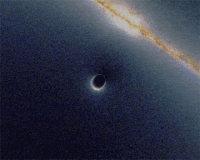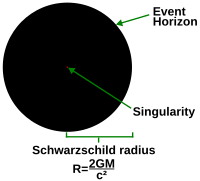Gravitational singularity

| General relativity |
|---|
 |
A gravitational singularity, spacetime singularity or simply singularity is a condition in which gravity is predicted to be so intense that spacetime itself would break down catastrophically. As such, a singularity is by definition no longer part of the regular spacetime and cannot be determined by "where" or "when". Gravitational singularities exist at a junction between general relativity and quantum mechanics; therefore, the properties of the singularity cannot be described without an established theory of quantum gravity. Trying to find a complete and precise definition of singularities in the theory of general relativity, the current best theory of gravity, remains a difficult problem.[1][2] A singularity in general relativity can be defined by the scalar invariant curvature becoming infinite[3] or, better, by a geodesic being incomplete.[4]
Gravitational singularities are mainly considered in the context of general relativity, where density would become infinite at the center of a black hole without corrections from quantum mechanics, and within astrophysics and cosmology as the earliest state of the universe during the Big Bang. Physicists are undecided whether the prediction of singularities means that they actually exist (or existed at the start of the Big Bang), or that current knowledge is insufficient to describe what happens at such extreme densities.[5]
General relativity predicts that any object collapsing beyond a certain point (for
Modern theory asserts that the initial state of the
Interpretation
Many theories in physics have
In classical field theories, including special relativity but not general relativity, one can say that a solution has a singularity at a particular point in spacetime where certain physical properties become ill-defined, with spacetime serving as a background field to locate the singularity. A singularity in general relativity, on the other hand, is more complex because spacetime itself becomes ill-defined, and the singularity is no longer part of the regular spacetime manifold. In general relativity, a singularity cannot be defined by "where" or "when".[10]
Some theories, such as the theory of loop quantum gravity, suggest that singularities may not exist.[11] This is also true for such classical unified field theories as the Einstein–Maxwell–Dirac equations. The idea can be stated in the form that, due to quantum gravity effects, there is a minimum distance beyond which the force of gravity no longer continues to increase as the distance between the masses becomes shorter, or alternatively that interpenetrating particle waves mask gravitational effects that would be felt at a distance.
Motivated by such philosophy of loop quantum gravity, recently it has been shown[12] that such conceptions can be realized through some elementary constructions based on the refinement of the first axiom of geometry, namely, the concept of a point [13] by considering Klein's prescription of accounting for the extension of a small spot that represents or demonstrates a point,[14] which was a programmatic call that he called as a fusion of arithmetic and geometry.[15] Klein's program, according to Born, was actually a mathematical route to consider `natural uncertainty in all observations' while describing `a physical situation' by means of `real numbers'.[16]
Types
There is only one type of singularity, each with different physical features that have characteristics relevant to the theories from which they originally emerged, such as the different shapes of the singularities, conical and curved. They have also been hypothesized to occur without event horizons, structures that delineate one spacetime section from another in which events cannot affect past the horizon; these are called naked.
Conical
A conical singularity occurs when there is a point where the limit of some
An example of such a conical singularity is a cosmic string and a Schwarzschild black hole.[17]
Curvature

Solutions to the equations of
An example is the
While in a non-rotating black hole the singularity occurs at a single point in the model coordinates, called a "point singularity", in a rotating black hole, also known as a
More generally, a spacetime is considered singular if it is
Naked singularity
Until the early 1990s, it was widely believed that general relativity hides every singularity behind an event horizon, making naked singularities impossible. This is referred to as the cosmic censorship hypothesis. However, in 1991, physicists Stuart Shapiro and Saul Teukolsky performed computer simulations of a rotating plane of dust that indicated that general relativity might allow for "naked" singularities. What these objects would actually look like in such a model is unknown. Nor is it known whether singularities would still arise if the simplifying assumptions used to make the simulation were removed. However, it is hypothesized that light entering a singularity would similarly have its geodesics terminated, thus making the naked singularity look like a black hole.[19][20][21]
Disappearing event horizons exist in the Kerr metric, which is a spinning black hole in a vacuum, if the angular momentum () is high enough. Transforming the Kerr metric to Boyer–Lindquist coordinates, it can be shown[22] that the coordinate (which is not the radius) of the event horizon is, , where , and . In this case, "event horizons disappear" means when the solutions are complex for , or . However, this corresponds to a case where exceeds (or in Planck units, ); i.e. the spin exceeds what is normally viewed as the upper limit of its physically possible values.
Similarly, disappearing event horizons can also be seen with the Reissner–Nordström geometry of a charged black hole if the charge () is high enough. In this metric, it can be shown[23] that the singularities occur at , where , and . Of the three possible cases for the relative values of and , the case where causes both to be complex. This means the metric is regular for all positive values of , or in other words, the singularity has no event horizon. However, this corresponds to a case where exceeds (or in Planck units, ); i.e. the charge exceeds what is normally viewed as the upper limit of its physically possible values. Also, actual astrophysical black holes are not expected to possess any appreciable charge.
A black hole possessing the lowest value consistent with its and values and the limits noted above; i.e., one just at the point of losing its event horizon, is termed extremal.
Entropy
Before
See also
- 0-dimensional singularity: magnetic monopole
- 1-dimensional singularity: cosmic string
- 2-dimensional singularity: domain wall
- Fuzzball (string theory)
- Penrose–Hawking singularity theorems
- White hole
- BKL singularity
- Initial singularity
References
- ISBN 019509591X.
- ^ a b Curiel, Erik (2021). "Singularities and Black Holes". Stanford Encyclopedia of Philosophy. Metaphysics Research Lab, Stanford University. Retrieved 1 October 2021.
- ^ "Singularities". Physics of the Universe.
- Einstein Online. 2 (1002). Max Planck Institute for Gravitational Physics. Archived from the originalon 2017-01-24. Retrieved 2015-10-20.
- ISBN 019509591X.
- ^ Moulay, Emmanuel. "The universe and photons" (PDF). FQXi Foundational Questions Institute. Retrieved 26 December 2012.
- ^ Wald, p. 99
- Cambridge University. Archived from the originalon 6 October 2014. Retrieved 26 December 2012.
- ISBN 978-0813528984.
- ISBN 9812563946.
- S2CID 119247455.
- S2CID 246942045.
- ^ Euclid; J. L. Heiberg; R. Fitzpatrick. Euclid's Elements of Geometry (PDF).
- ^ Klein, Felix (2016). Elementary Mathematics From A Higher Standpoint. Springer Berlin Heidelberg.
- ^ Klein, Felix (2011). The Evanston Colloquium Lectures on Mathematics Delivered From Aug. 28 to Sept. 9, 1893 Before Members of the Congress of Mathematics Held in Connection with the World's Fair in Chicago (PDF). The Project Gutenberg.
- ^ Born, Max (1968). Physics in My Generation. Springer New York.
- S2CID 140465.
- ^ If a rotating singularity is given a uniform electrical charge, a repellent force results, causing a ring singularity to form. The effect may be a stable wormhole, a non-point-like puncture in spacetime that may be connected to a second ring singularity on the other end. Although such wormholes are often suggested as routes for faster-than-light travel, such suggestions ignore the problem of escaping the black hole at the other end, or even of surviving the immense tidal forces in the tightly curved interior of the wormhole.
- PMID 28163651. Archived from the originalon 2015-12-21.
- S2CID 119441682.
- S2CID 19851285.
- ^ Hobson, et al., General Relativity an Introduction for Physicists, Cambridge University Press 2007, p. 300-305
- ^ Hobson, et al., General Relativity an Introduction for Physicists, Cambridge University Press 2007, p. 320-325
- S2CID 122758428.
Bibliography
- Earman, John (1995). Bangs, crunches, whimpers, and shrieks: Singularities and acausalities in relativistic spacetimes. Oxford University Press. ISBN 019509591X.
- Joshi, Pankaj S (2007). Gravitational collapse and spacetime singularities. New York: Cambridge University Press. ISBN 9781107405363.
- ISBN 0-7167-0344-0. §31.2 The nonsingularity of the gravitational radius, and following sections; §34 Global Techniques, Horizons, and Singularity Theorems
- ISBN 0-226-87033-2.
- (Free access.)
- Shapiro, Stuart L.; S2CID 7830407.
- Penrose, Roger (1996). "Chandrasekhar, Black Holes, and Singularities". ias.ac.in.
- Penrose, Roger (1999). "The Question of Cosmic Censorship". ias.ac.in.
- Singh, T.P. (1999) "Gravitational Collapse, Black Holes and Naked Singularities". ias.ac.in.
Further reading
- layman's introduction to string theory, although some of the views expressed are already becoming outdated. His use of common terms and his providing of examples throughout the text help the layperson understand the basics of string theory.






















